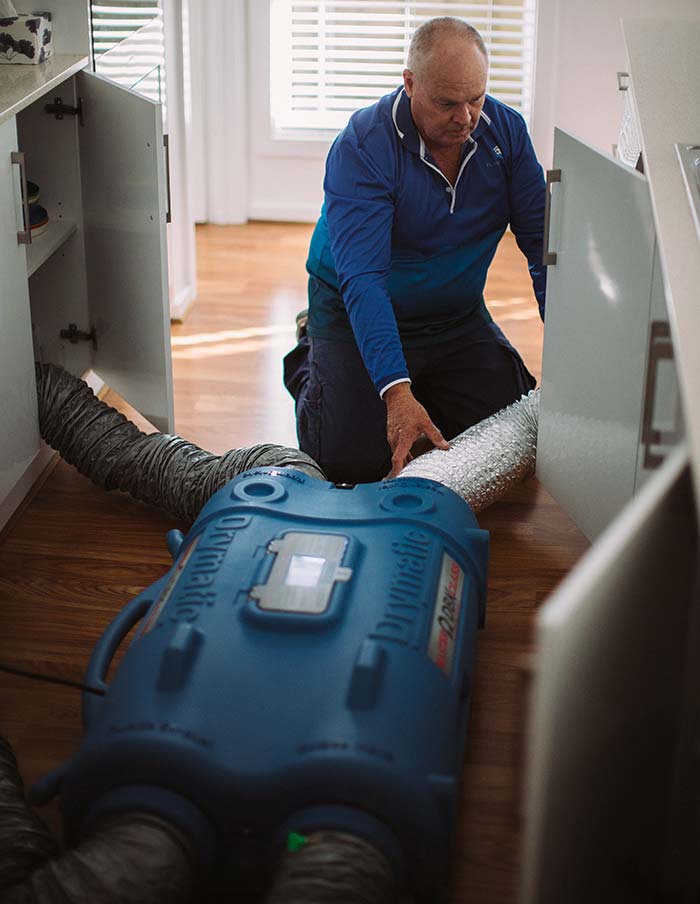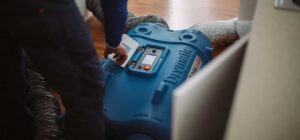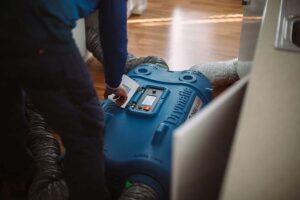How to Dry Wet Timber Floors After a Minor Water Spill
When water spills onto timber floors, time is critical. Timber is highly porous, so even a small amount of water can quickly seep into the wood and sub-flooring, leading to warping, cupping, or mould growth if not dealt with promptly. Acting fast can prevent permanent damage and save you from costly repairs down the line.
Step 1: Remove Surface Water Immediately
Start by mopping up as much water as possible using absorbent towels or a mop or extract excess water with a wet vac if your have one. After the initial water removal, go over the affected area again with dry towels to soak up any remaining moisture on the surface. This simple step helps limit how much water penetrates into the wood.
Step 2: Clean and Disinfect the Area
Once the surface water is gone, clean the water affected area with a mild disinfectant. This will help prevent bacteria or mould spores from taking hold. After cleaning, dry the area thoroughly with fresh towels so that no additional moisture is introduced.
Step 3: Improve Ventilation and Airflow
Open windows and doors to allow fresh air to circulate throughout the space. This air exchange helps reduce indoor humidity and speeds up the drying process. If the weather is warm and dry, the natural airflow will make a big difference.
Step 4: Apply Heat to Speed Up Evaporation
Timber responds well to gentle heat when drying. You can:
-
Turn on your air conditioner in heating mode.
-
Use a portable heater positioned safely near the wet flooring.
-
Hire an industrial air mover or carpet blower from a local equipment hire shop.
The goal is to create consistent, warm airflow across the wet timber. This accelerates evaporation, helping moisture trapped within the wood escape more efficiently.
Step 5: Use Fans for Continuous Air Circulation
Set up oscillating fans or portable air movers aimed directly at the affected area. The constant movement of warm air over the floor will help dry both the surface and deeper layers of the timber.
Step 6: Be Patient – Drying Takes Time
Even with fast action, timber floors can take two to three days or longer to dry completely, especially if moisture has penetrated into the subfloor. Check the area regularly and keep heat and airflow going until you’re certain the wood is fully dry.
Pro Tip: When to Call the Professionals
If the spill covered a large area or water has soaked into the floor for several hours before you started drying, consider contacting a professional water damage restoration company. They have specialised drying equipment, including heat drying systems and moisture meters, to ensure your timber floors are completely dry and protected against long-term damage.
Timber Floor Drying Guide for Minor Water Spills
Timber floors can withstand the occasional minor water spill if handled quickly, but the key is to act fast. Even small amounts of water left sitting on timber can lead to swelling, staining, or long-term structural issues if not properly dried.
The process below applies to small spills only. If your timber floors have been flooded or suffered severe water damage, it’s strongly recommended that you contact a professional water damage restoration company or timber floor drying specialist for expert assistance.
Step-by-Step Process for Drying Wet Timber Floors
-
Act quickly – Do not let water sit on the surface. The longer it remains, the more time it has to seep into the wood and subfloor.
-
Remove standing water – Use absorbent towels or a mop to soak up as much moisture as possible. Once the surface water is gone, go over the area again with dry towels to eliminate any remaining dampness.
-
Clean the affected area – Use a mild household disinfectant to wipe down the wet flooring. This helps prevent mould and bacteria from spreading while the timber dries.
-
Apply heat – Raise the temperature in the affected room with a portable heater or heating system. Gentle, consistent warmth will help speed up the evaporation process without damaging the timber.
-
Increase airflow – Open windows and doors to promote natural ventilation. For better results, set up oscillating fans or hire an air mover to push air across the surface.
-
Allow time to dry – Even minor spills can take 48–72 hours to fully dry, depending on how much water was absorbed. Keep heat and airflow consistent until you’re confident the wood is moisture-free.
-
Seek professional help for larger incidents – If water has soaked in for several hours or covered a large area, professional drying equipment may be required to prevent long-term damage.
How Flooding Can Affect Timber Floors
While small spills are usually manageable with prompt action, flooding or significant water damage can cause serious structural problems for timber floors. Issues that commonly occur after major water exposure include:
-
Swelling – Timber boards absorb water and expand, putting pressure on the surrounding boards.
-
Cupping – Edges of the boards rise higher than the centre, creating an uneven, wavy appearance.
-
Buckling – In severe cases, boards can lift away from the subfloor entirely.
-
Gapping – As moisture evaporates and the timber dries, shrinkage may leave visible gaps between boards.
-
Mould growth – Prolonged dampness creates the perfect environment for mould and mildew to develop.
The Role of Professional Structural Drying
For floors impacted by flooding or extensive water intrusion, professional structural drying services are often necessary. Specialists use heat drying systems, industrial dehumidifiers, and moisture detection tools to restore timber floors safely and effectively.
In many cases, professional drying can save timber flooring that might otherwise require complete replacement, protecting both the property’s structure and value.
How can Flood Fixers help with timber floor drying on the Gold Coast.
If your timber floors have been badly flooded and they are showing obvious signs of swelling and water damage, then you will need to call in a professional water damage restoration company to assist you with rectifying or at least reducing the impact of the water damage to your timber floors.
The expert team at Flood Fixers have been successfully drying water damaged timber floors on the Gold Coast for many years and we are only too happy to help you with your timber floor issues.
Our friendly team can inspect and assess your water damaged timber floors on the Gold Coast and then advise you how we can help with the drying and restoration process. As with any water damage situation it’s best to act fast, the sooner we can inspect and begin drying your water damaged timber floors the more chance we will have of providing a successful outcome.
The Flood Fixers Process for Wet Timber Floor Drying on the Gold Coast
At Flood Fixers, we understand that wet timber floors require a specialised approach compared to other water-damaged surfaces. Unlike carpet and underlay, which soak up water like a sponge, timber flooring doesn’t hold a large volume of water on the surface. Instead, the moisture that does seep in penetrates deep into the wood’s structure, where it becomes what professionals call bound moisture.
This deeply embedded moisture is challenging to remove with standard drying methods. If left untreated, it can lead to long-term damage such as warping, cupping, and even mould growth. That’s why our team relies on advanced heat drying technology specifically designed for timber floor water damage restoration.
How We Dry Wet Timber Floors
-
Initial Assessment and Moisture Removal
Our technicians begin by inspecting the affected timber flooring and extracting any surface water. While timber doesn’t hold as much water as carpet or underlay, removing all excess moisture is essential before moving to the drying phase. -
Anti-Bacterial Cleaning and Preparation
We then clean the water-affected area with anti-bacterial treatments to prevent mould growth and eliminate contaminants left behind by the water damage. -
Setting Up Heat Drying Systems
Using specialised heat drying mats and controlled air movement, we gently raise the temperature of the timber flooring. This process significantly increases the evaporation rate, forcing moisture from deep within the wood to the surface where it can be safely removed. -
Monitoring and Moisture Readings
Throughout the process, we take regular moisture readings with professional-grade meters to track progress. This ensures the flooring is drying evenly and prevents over-drying, which can cause additional stress to the timber. -
Restoring Structural Integrity
As the drying continues, the timber gradually relaxes and returns to its natural state, reducing cupping and unevenness caused by water damage. In many cases, this process allows us to save the original flooring without the need for full replacement. -
Sanding and Refinishing if Required
In severe cases, where water damage has altered the timber’s surface finish, light sanding and re-sealing may be required to restore the floor’s appearance after drying.
Why Heat Drying is the Gold Standard for Timber Floors
The heat drying system we use at Flood Fixers has transformed how water-damaged timber floors are restored across the Gold Coast. By combining heat, airflow, and precise moisture monitoring, we can deliver faster, more effective results while saving homeowners the high cost and inconvenience of ripping out and replacing timber floors.
Comprehensive Water-Damaged Timber Floor Assessment on the Gold Coast
When timber floors are impacted by flooding, burst pipes, or severe leaks, quick and accurate assessment is essential to prevent permanent damage. At Flood Fixers, we specialise in water-damaged timber floor assessments across the Gold Coast, helping homeowners and businesses understand the full extent of the damage and determine the best course of action for structural drying and restoration.
Our team combines years of industry experience with advanced diagnostic tools to ensure no hidden moisture goes undetected. A proper assessment is the first step toward saving your timber floors and avoiding costly replacements.
What’s Included in a Timber Floor Water Damage Assessment
Our Gold Coast timber floor inspections go beyond a simple visual check. We use a comprehensive approach to ensure the most accurate assessment possible, including:
-
Detailed visual inspection – We carefully examine the entire affected area, looking for early signs of warping, cupping, staining, or mould growth.
-
Thermal imaging scans – Advanced thermal cameras help identify hidden moisture beneath the timber surface and in subfloor structures, even when it’s invisible to the naked eye.
-
Moisture content readings – We use professional moisture meters to measure the bound moisture deep within the timber. These readings are essential for determining how much drying is required.
-
Relative humidity testing – By measuring indoor humidity levels, we can assess whether environmental conditions could slow the drying process or encourage mould growth.
-
Airborne particle count testing – In cases where water damage has been left untreated, we check for airborne mould spores to ensure the property is safe and healthy.
Why Professional Assessment Matters
Timber floors can often be saved if water damage is dealt with quickly and effectively. However, moisture trapped deep within the wood can cause swelling, cupping, buckling, or even structural instability if ignored.
Our expert team can create a tailored structural drying and remediation plan based on the findings of our assessment. In many cases, our advanced heat drying systems can restore water-damaged timber floors without the need for full replacement, saving homeowners time, money, and stress.
Friendly, Reliable Water Damage Support On The Gold Coast
At Flood Fixers, we pride ourselves on being approachable and professional. Whether you need a full water damage restoration service or just obligation-free advice, our team is here to help 24/7.
We work across the entire Gold Coast region, offering fast response times and the latest water damage restoration technology to protect your home or business from long-term damage.






